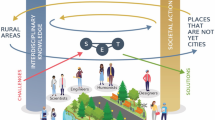Abstract
From the ecological viewpoint this paper discusses the urban spatial-temporal relationship. We take regional towns and cities as a complex man-land system of urban eco-community. This complex man-land system comprises two elements of “man” and “land”. Here, “man” means organization with self-determined consciousness, and “land” means the physical environment (niche) that “man” depends on. The complex man-land system has three basic components. They are individual, population and community. Therefore there are six types of spatial relationship for the complex man-land system. They are individual, population, community, man-man, land-land and man-land spatial relationships. Taking the Pearl(Zhujiang) River Delta as a case study, the authors found some evidence of the urban spatial relationship from the remote sensing data. Firstly, the concentration and diffusion of the cities spatial relationship was found in the remote sensing imagery. Most of the cities concentrate in the core area of the Pearl River Delta, but the diffusion situation is also significant. Secondly, the growth behavior and succession behavior of the urban spatial relationship was found in the remote sensing images comparison with different temporal data. Thirdly, the inheritance, break, or meeting emergency behavior was observed from the remote sensing data. Fourthly, the authors found many cases of symbiosis and competition in the remote sensing data of the Pearl River Delta. Fifthly, the autoeciousness, stranglehold and invasion behavior of the urban spatial relationship was discovered from the remote sensing data.
Similar content being viewed by others
References
DUAN Jing, 1997. The symbiosis and competition of urban group development[J]. New Architecture, 7(1): 24–26. (in Chinese)
HUANG Guang-yu, CHEN Yong, 1997. Ecological cities and its planning methodology [J]. City Planning Review, 21(1): 47–51. (in Chinese)
HUANG Guang-yu, CHEN Yong, TIAN Ling, 1999. Ecological planning methods application in urban planning[J]. City Planning Review, 23(6): 48–51. (in Chinese)
HUANG Zhao-yi, YANG Dong-yuan, 2001a. The theoretical approach of the ecological city[J]. City Planning Review, 25(1): 59–66. (in Chinese)
HUANG Zhao-yi, YANG Dong-yuan, 2001b. On the analyzing methods for evaluating ecological footprint in terms of sustainable growth [J]. City Planning Review, 25(11): 26–32. (in Chinese)
MA Shi-jun, 1990. Modern Ecology Perspective[M]. Beijing: Science Press, 1–5. (in Chinese)
YU Kong-jian, LI Di-hua, 1997. Landscape patterns of urban-countryside and regional planning[J]. Urban Planning Overseas, 12(3): 12–16. (in Chinese)
YU Kong-jian, YE Zheng, LI Di-hua, 1998. Connectivity of landscape ecological process and patterns[J]. City Planning Review, 22(4): 27–31. (in Chinese)
YU Kong-jian, ZHANG Dong, 2001. Cells, landscape pattern and network innovation[J]. City Planning Review, 25(5): 42–47. (in Chinese)
ZHANG Hui-yuan, NI Jing-ren, 2001. Spatial ways discussion of urban landscape control[J]. City Planning Review, 25(7): 15–18. (in Chinese)
ZHANG Jing-xiang, 2000. Combination of Urban Group Space[M]. Nanjing: Southeast University Press, 1–19. (in Chinese)
ZHANG Yu-xin, 1995. Discussion of the ecological space[J]. City Planning Review, 19(2): 17–19. (in Chinese)
ZHAO Cheng, 1997. Spatial competition system of urban development[J]. New Architecture, 7(1): 9–11. (in Chinese)
Author information
Authors and Affiliations
Additional information
Foundation item: Under the auspices of the National Natural Science Foundation of China (No. 69896250-4).
Biography: HU Wei-ping(1969 —), male, a native of Hengyang City of Hunan Province, Ph. D., specialized in the application of RS and GIS.
Rights and permissions
About this article
Cite this article
Hu, Wp., Zhu, Yz. Knowledge discovery of remotely sensed data from ecological view. Chin. Geograph.Sc. 13, 48–55 (2003). https://doi.org/10.1007/s11769-003-0084-6
Received:
Issue Date:
DOI: https://doi.org/10.1007/s11769-003-0084-6
Key words
- complex man-land system of urban eco-community
- spatial-temporal relationship
- knowledge discovery
- remote sensing
- the Pearl River Delta




